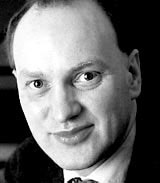The festival hall of fame
Hugh Pearman enjoyed hearing a roomful of design luminaries recount the Festival of Britain, but wonders if such an uncynical zeitgeist can ever be reached again

Just occasionally, the mass media can unexpectedly throw up something interesting. And usually, it’s on the radio. It is one of those little truisms that radio does visual subjects far better than television. Pictures tend to get in the way. Anyone in favour of that TV series called Restoration, made by the makers of Big Brother? Best to pass hurriedly on. At least the home-and-garden makeover programmes are entertaining.
What I heard on the radio was a group of old codgers reminiscing. Radio is as brilliant at this as it is at doing visual stuff. It’s cheap to make and it’s very good. It doe
sn’t really matter what they are reminiscing about. When they start to speak, listeners fall into a fascinated silence, just as children do when granny starts talking about how she got engaged to a Belgian during the war. The National Health Service – yes, just how did they go about setting that up? How did you get over being brought up in a Barnardo’s home? Why did people stand for rationing right into the 1950s?
The group of old codgers who caught my attention on the radio could well have talked about rationing, but brushed it aside. They were a clutch of the surviving designers from the Festival of Britain in 1951, taking part in the Radio 4 series called The Reunion. It should have been done about five years ago when more of the key players were still alive. Still, we got one room containing designers Sir Terence Conran, Robin and Lucienne Day, plus architects Leonard Manasseh and Jean Symons. The downside was that they had to talk to Sue MacGregor, the upside was they managed this with aplomb.
Conran was only 19 when he acted as a design assistant to architect Dennis Lennon at the festival as well as gophering for other designers. His story of making resin letters full of shellfish and caterpillars that then exploded, releasing a fearsome stink, is familiar enough, but Conran also talked of sleeping on a camp bed at the festival site for six weeks, and of creeping away on opening day, too junior to have been invited to the ceremony. Robin Day spoke of working like a maniac – not least on the seating for the Festival Hall, still in use today. Lucienne recounted wangling her fabrics and wallpapers into the exhibition – while always wearing black, with a big black hat and white gloves when necessary. Symons, who photographed the building works, remembers the festival’s director, Sir Hugh Casson, wandering around the site, staring at Waterloo Station and asking rhetorically: ‘How on earth shall I hide that?’. He’d already worked it out – he hid it with a wall of big coloured balls.
‘It was wonderful. Absolutely wonderful. One of the happiest times of my life. It was people in demob suits dancing in the rain,’ said Manasseh, now 87, one of the sweetest and truest men in the business. And all he did was design a bar and some lavato
ries, having had his state-of-the-art glass-floored restaurant design, intended to be cantilevered out over the Thames, abandoned on cost grounds. Who cares? He had a great time.
Naturally, they discussed the difference between now and then, and particularly between the festival and the Dome. Government meddling soured the Millennium celebrations, they agreed – but they also agreed that the Dome, as a building, is a great one.
As for the festival’s influence, you got the feeling that that was overrated. Then, as now, people were happy to look at futuristic designs but less happy to have them in their homes. It was to be another 13 years before the conditions were right for Conran to start Habitat, and decades more before the Days reached legendary status, with re-editions of their 1950s work, retrospective exhibition and so forth.
Manasseh lamented the destruction of the Skylon – the illuminated cigar-like object that was the 3D emblem of the festival – but I’m not so sure. I recall tackling its architects, the late Sir Philip Powell and Hidalgo ‘Jacko’ Moya about this, and they took the robust view that it would have looked sad and tacky after a few years – unlike the timeless Festival Hall, which was always designed to last.
No, it was the social circumstances that made the festival, and you cannot repeat those. A good old codgers’ radio programme such as this one gave you a brief glimpse into the mindset of the time. It was optimistic, confident, unafraid of hard work, prepared to have a good time. Above all, it was uncynical. We shall not see those days again. We just know too much to ever be able to re-create them.
Please e-mail comments for publication in the Letters section to lyndark@centaur.co.uk
-
Post a comment




